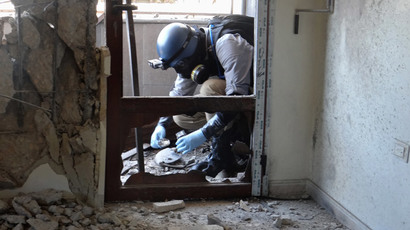600 tons of Syria's chemical arsenal loaded onto US ‘neutralizer’ ship

Hundreds of tons of the most hazardous Syrian chemical arsenal have been handed over to the US vessel which has special equipment to neutralize a dangerous stockpile. The chemicals have now left Italy to be destroyed at sea.
The MV Cape Ray has left the port of Gioia Tauro after a 12-hour operation which witnessed the transfer of the chemicals from a Danish ship, the Ark Futura, that was taking part in an international effort to turn Damascus into a chemical weapons free state.
The cargo consisting of mustard gas and the raw materials for sarin nerve gas will now be destroyed in the middle of the Mediterranean Sea, but the operation is expected to last at least several weeks to complete. The stockpile will be destroyed in international waters “in a safe and environmentally sound manner,” says the US Department of Defense.
Syria handed over 100% of declared chem weapons stockpile – watchdog

“Neutralization operations will soon begin,” Defense Department said in a statement. Cape Ray is equipped with two Field Deployable Hydrolysis Systems designed specifically for the mission to transform the material into low-level hazardous industrial waste.
According to the experts, however the transformation process may take from 60 to 90 days and depends on the weather conditions.
“Never before has an entire arsenal of a category of weapons of mass destruction been removed from a country experiencing a state of internal armed conflict,” said Ahmet Uzumcu, the director general of OPCW. “And this has been accomplished within very demanding and tight timeframes.”

Two shipboard field deployable hydrolysis systems on the American ship designed specifically for the mission will transform the material into low-level hazardous industrial waste.
Once neutralized, the remaining material will still be considered dangerous. However, the substance can’t be further used to create chemical weapons. These materials will be processed by facilities in Germany and Finland.
According to the experts, the transformation process will take from 60 to 90 days and depends on the weather conditions.
“Never before has an entire arsenal of a category of weapons of mass destruction been removed from a country experiencing a state of internal armed conflict,” said Ahmet Uzumcu, the director general of OPCW. “And this has been accomplished within very demanding and tight timeframes.”

Once neutralized, the remaining material will still be considered dangerous. However, the substance can’t be further used to create chemical weapons. These materials will be processed by facilities in Germany and Finland.
Italian authorities have spent Wednesday offloading the 78 containers of dangerous cargo from the Italian vessel that delivered the arsenal from Syria. The transfer has been hailed as “transparent and environmentally secure operation,” by Italy's environment minister, Gian Luca Galletti via Twitter.
The last 8 percent of the initial 1,300 tons of hazardous material was loaded aboard the Danish ship June 23.
The removal of chemical agents from Syria began in early January, following an agreement brokered by Russia, in which Syria renounced its chemical weapons arsenal and joined the convention on Prohibition of the Development, Production, Stockpiling and Use of Chemical Weapons.
















